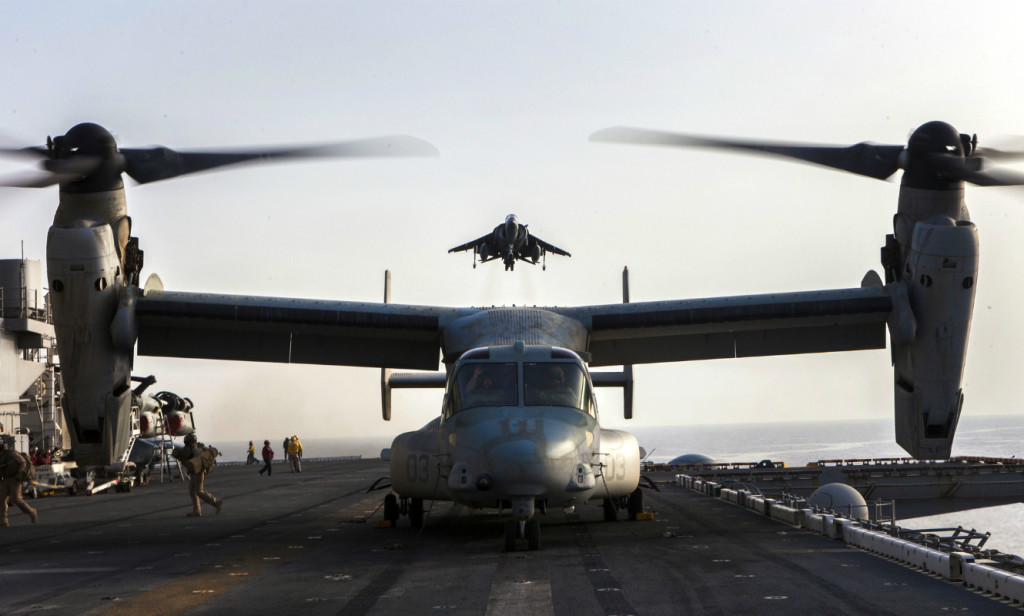Demands on the Marine Corps are Slowly Breaking Marine Aviation

Last month’s release of the 2016 Marine Corps Aviation Plan highlighted the service’s struggles to keep its planes flying and its pilots trained. Lt. Gen. Jon Davis, the deputy commandant for aviation, stated in the report’s introduction that the Corps has seen “a decrease in flight hours per month per aircrew and an uptick in [its] mishap rates,” leading to concerns about the readiness of Marine squadrons. These challenges stem, in part, from two conditions impacting the force as a whole: The Corps is continuing to deploy thousands worldwide even as the size of the force has shrunk; and the budgetary turmoil of the past few years has prevented the service from carrying out important maintenance and equipment updates. Aviation readiness will continue to suffer despite the best efforts of the Marine Corps unless adequate funding levels are maintained and operational commitments are limited to what is sustainable.
Bryan Clark and I described the difficulties posed by the Corps’ high operational tempo (OPTEMPO) in our recent report, Deploying Beyond Their Means: America’s Navy and Marine Corps at a Tipping Point. Although the U.S. troop commitment in Afghanistan has fallen precipitously, the resumption of a rotational deployment program in the Pacific and an increasing number of deployments in response to contingencies in Africa continue to place large demands on Marine manpower. The Corps is also in the midst of a drawdown that will ultimately reduce its overall strength to 182,000 by 2017. There are currently some 30,000 marines deployed overseas out of an active force of 186,000. That total is just 6,000 fewer than in January 2014, when there were more than 196,000 men and women on active duty. The Corps’ manning and resources are declining faster than its operational commitments.
The Marine Corps’ punishing OPTEMPO is taking a toll on Marine aviation’s people and hardware. Global security commitments have forced the service to sustain a deployment-to-dwell (D2D) ratio in the active force of 1:2, or two months at home for every month deployed. This figure is well below the ideal ratio of 1:3, which the Corps has determined would be optimal for the health of the force. Personnel assigned to units that are in particularly high-demand, such as MV-22 Osprey and KC-130 tanker squadrons, are enduring D2D ratios below 1:2. These excessive deployment requirements tax the force in a myriad of ways, from reducing marines’ time with their families to preventing them from receiving training that is critical to their individual readiness. In the long term, insufficient downtime between deployments can adversely affect the Corps by pushing its most experienced marines to leave the service.
Aircraft are also suffering from the operational demands being placed on them. Current global requirements have precluded any “reset” following the wars in Iraq and Afghanistan. The unprecedented flight time these aircraft incurred during combat has prematurely aged many platforms. Some, like the F/A-18 Hornet, have served well beyond their intended lifespan and are kept flying only with the help of costly modifications and extensive maintenance. Both measures eat up precious funding and extend the time the platforms must spend in the hangar instead of in the air.
The Corps is still contending with the effects of the 2013 sequestration, when the service was forced to make dramatic spending cuts by furloughing key civilian specialists and stopping overtime work. These furloughs, in turn, slowed the pace at which aircraft can go through depot maintenance, leading to a backlog of airframes waiting to undergo overhaul. As a result, aviators in the fleet are struggling to maintain their skills with limited numbers of aircraft to fly. The Corps has concluded that it is 20 percent short of the aircraft necessary to meet its readiness standards, defined as having a squadron complete 70 percent or more of its essential training requirements. Squadrons that have low readiness ratings present more of a safety risk in peacetime and threaten to erode the qualitative edge that U.S. pilots have historically enjoyed in combat.
The 2016 Aviation Plan identifies material readiness as being “the key component to current readiness,” and outlines some initiatives to increase the number of Ready Basic Aircraft (RBA) that squadrons can field. The Corps is in the process of carrying out independent readiness reviews on a number of its legacy platforms in order to identify areas for improvement, such as improving sustainment management and ensuring squadrons have access to an adequate supply of spare parts. In addition, the new airframes many squadrons will be receiving as they transition to advanced platforms may help alleviate some maintenance woes.
In the long run, however, there is no escaping the reality that current global requirements are severely taxing a Marine Corps that is much smaller and more fiscally constrained than it was several years ago. Maintenance process improvements can only do so much if too few aircraft and aircrew are being asked to fly too often. Marine leaders have declared their intention to focus on readiness and are striving to achieve dramatic, across-the-board improvements by 2020. To be successful, the Corps will need to receive a steady, predictable stream of funding — a repeat of the 2013 sequester would be disastrous — and the service’s OPTEMPO must be contained to limit the stress placed on both equipment and personnel. It may be possible to “do the same with less,” as former Commandant Gen. James Amos declared in 2014, but if Marine aviators are asked to “do more with less,” the community will inevitably suffer an even further degradation of its readiness and combat capability.
Jesse Sloman is a research assistant at the Center for Strategic and Budgetary Assessments and an officer in the Marine Corps Reserve. He served on active duty from 2009 to 2013.
Photo credit: Sgt. Christopher Q. Stone, U.S. Marine Corps

